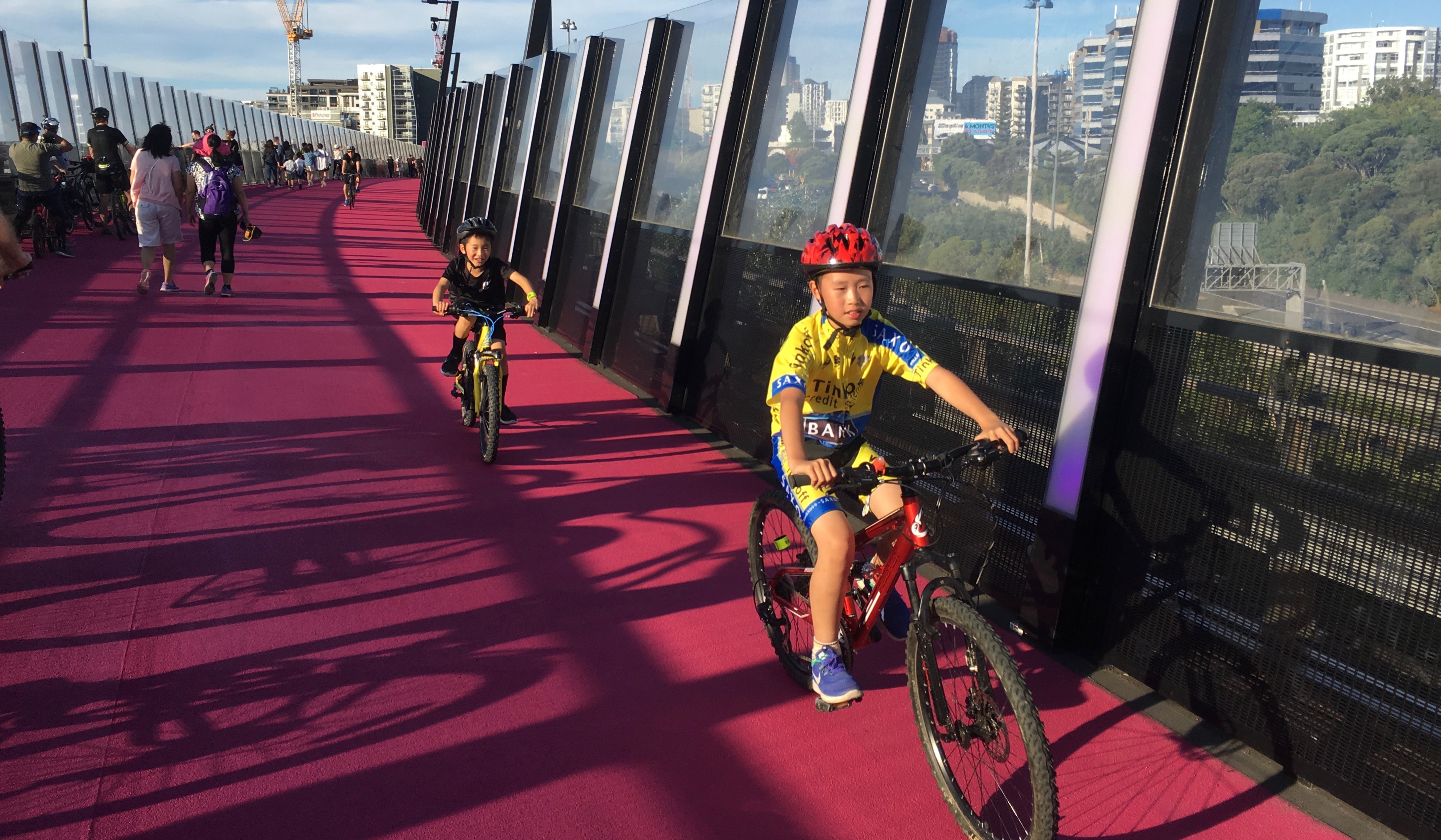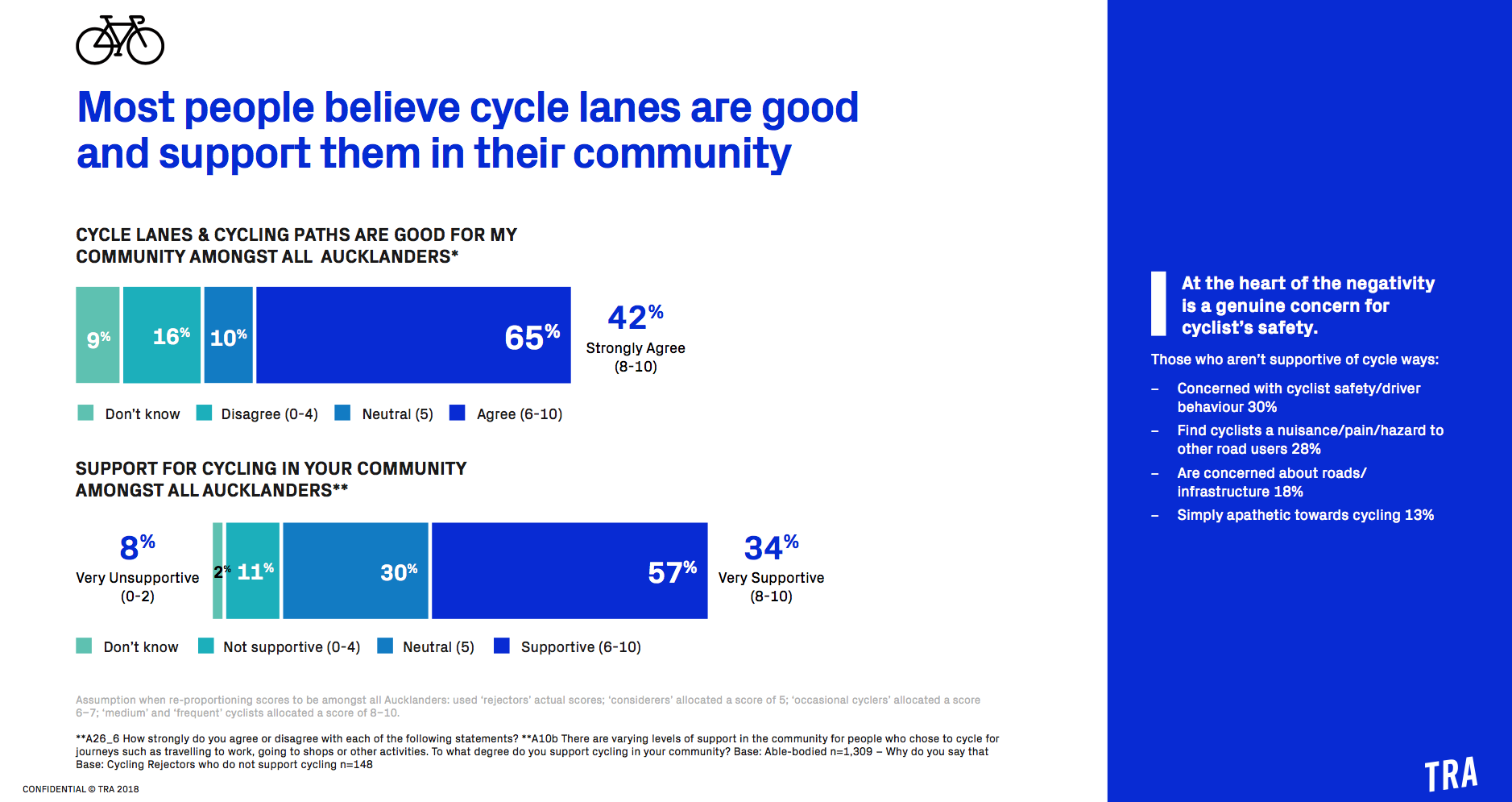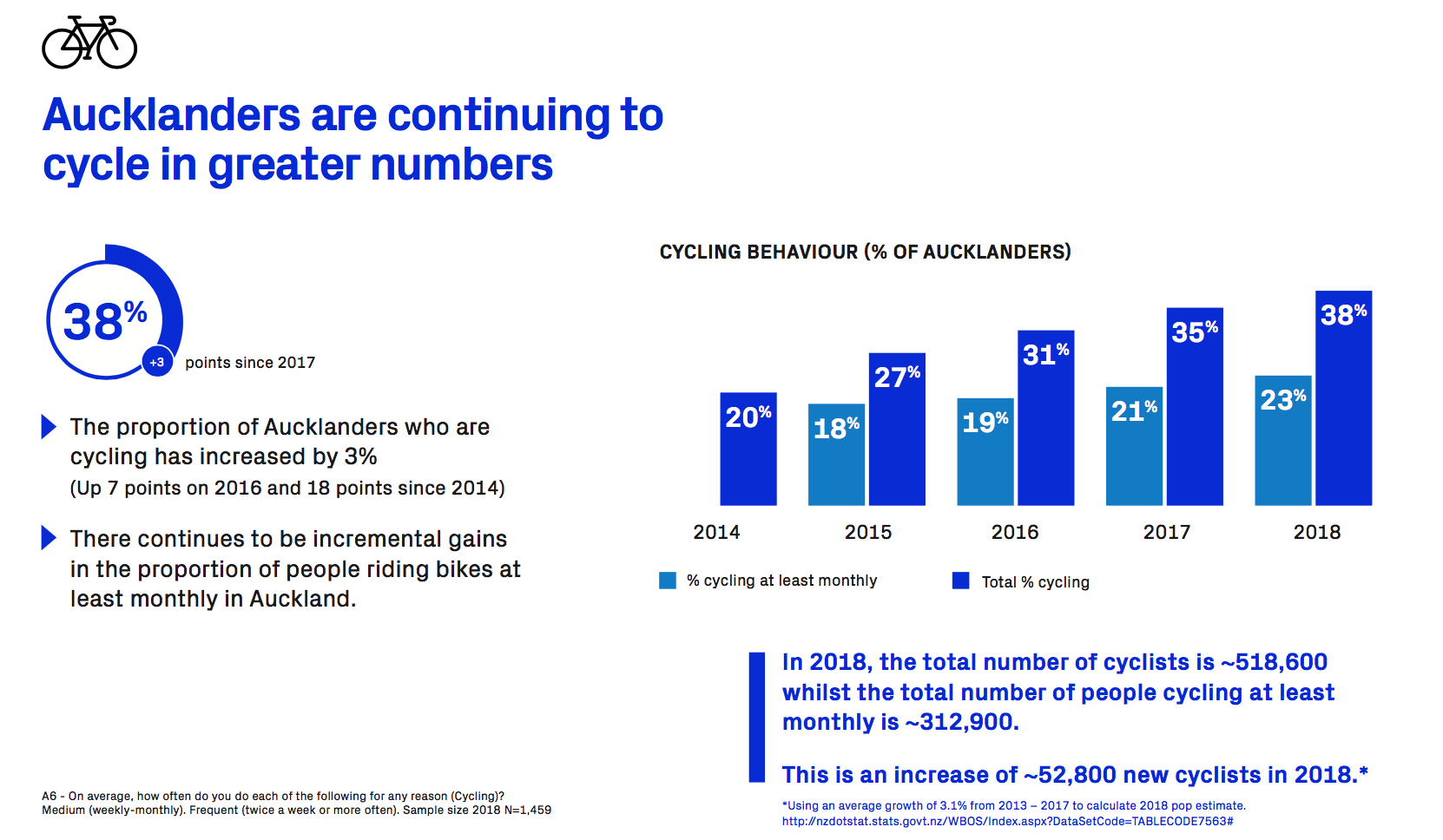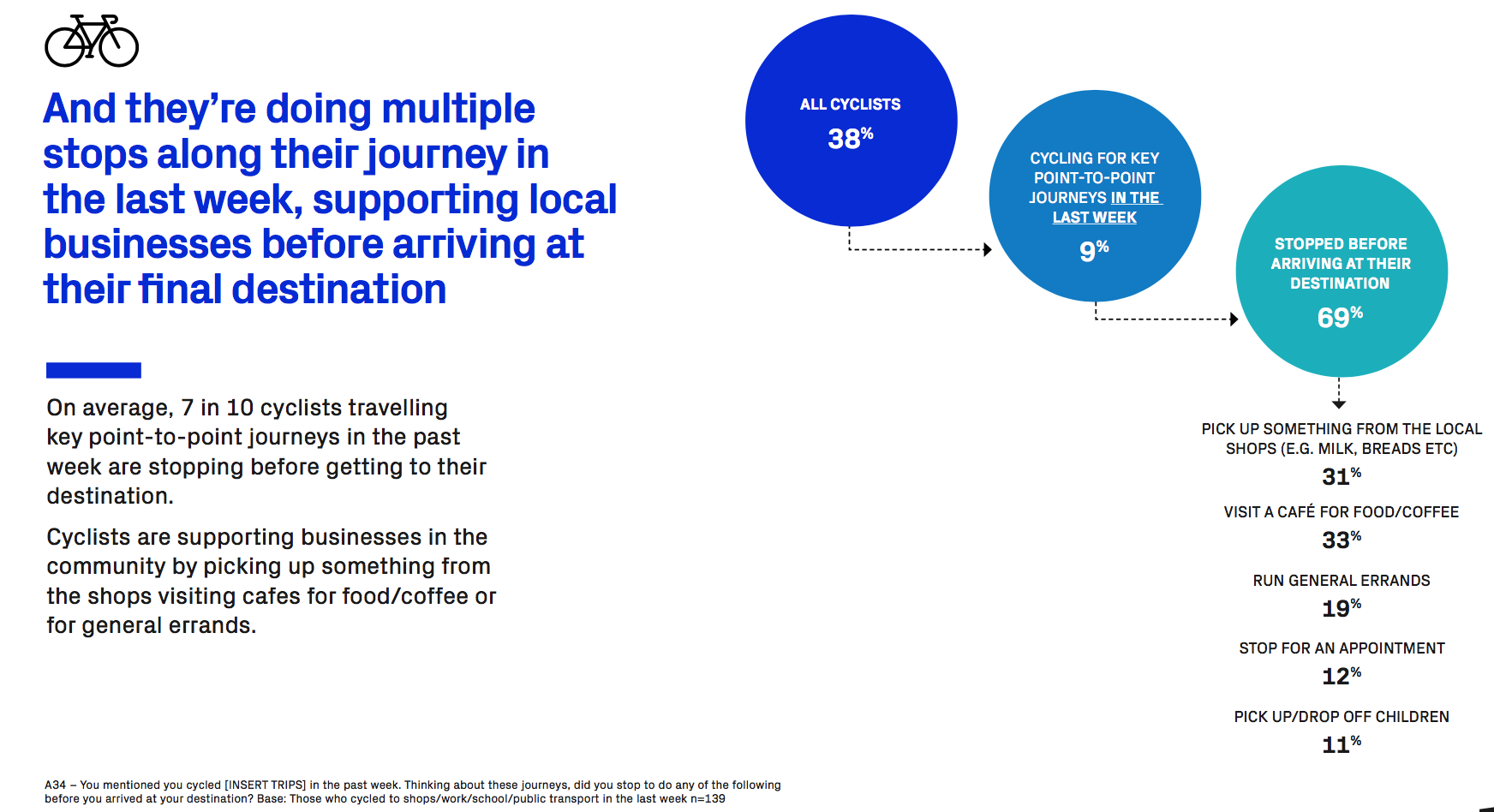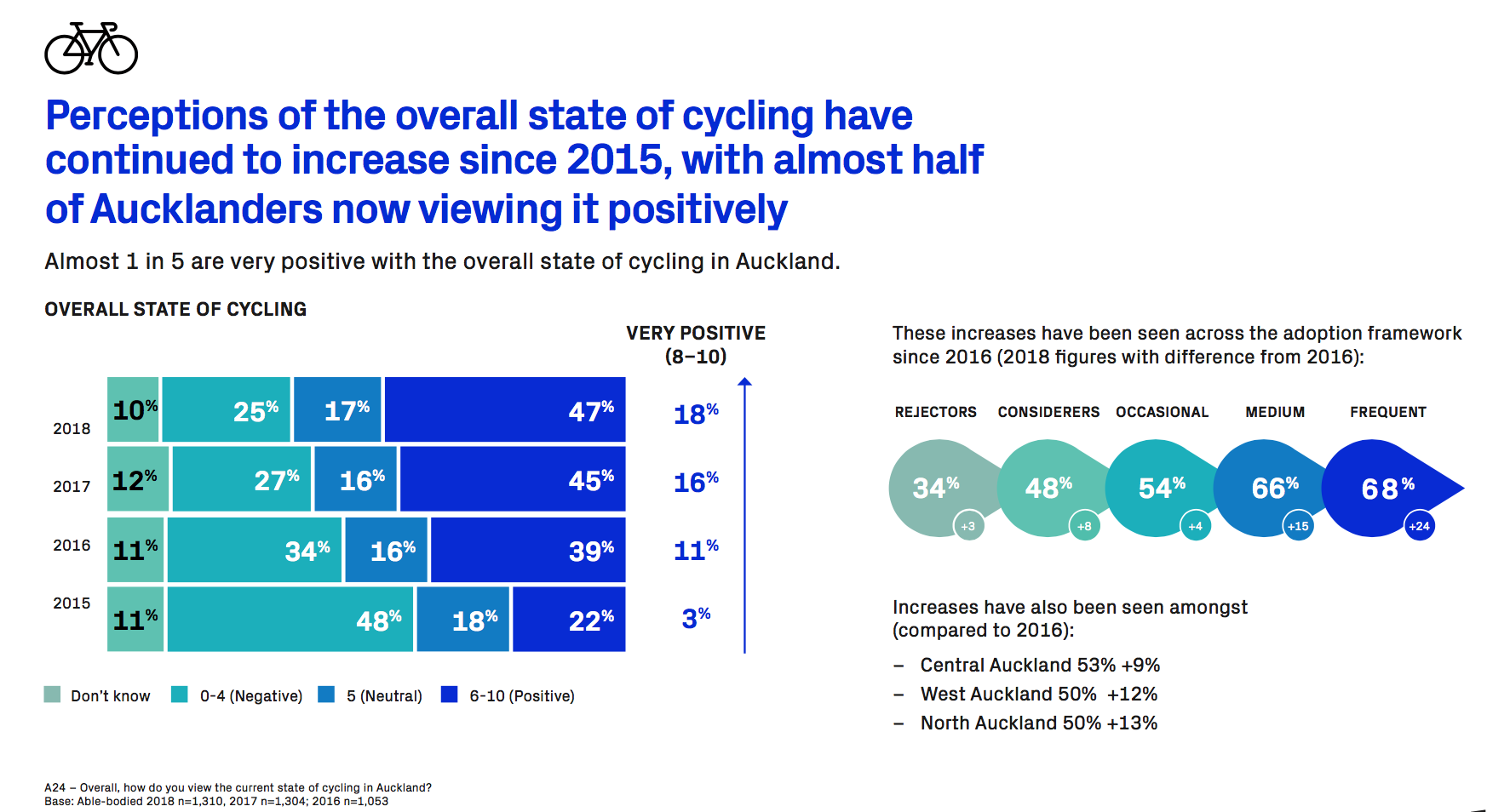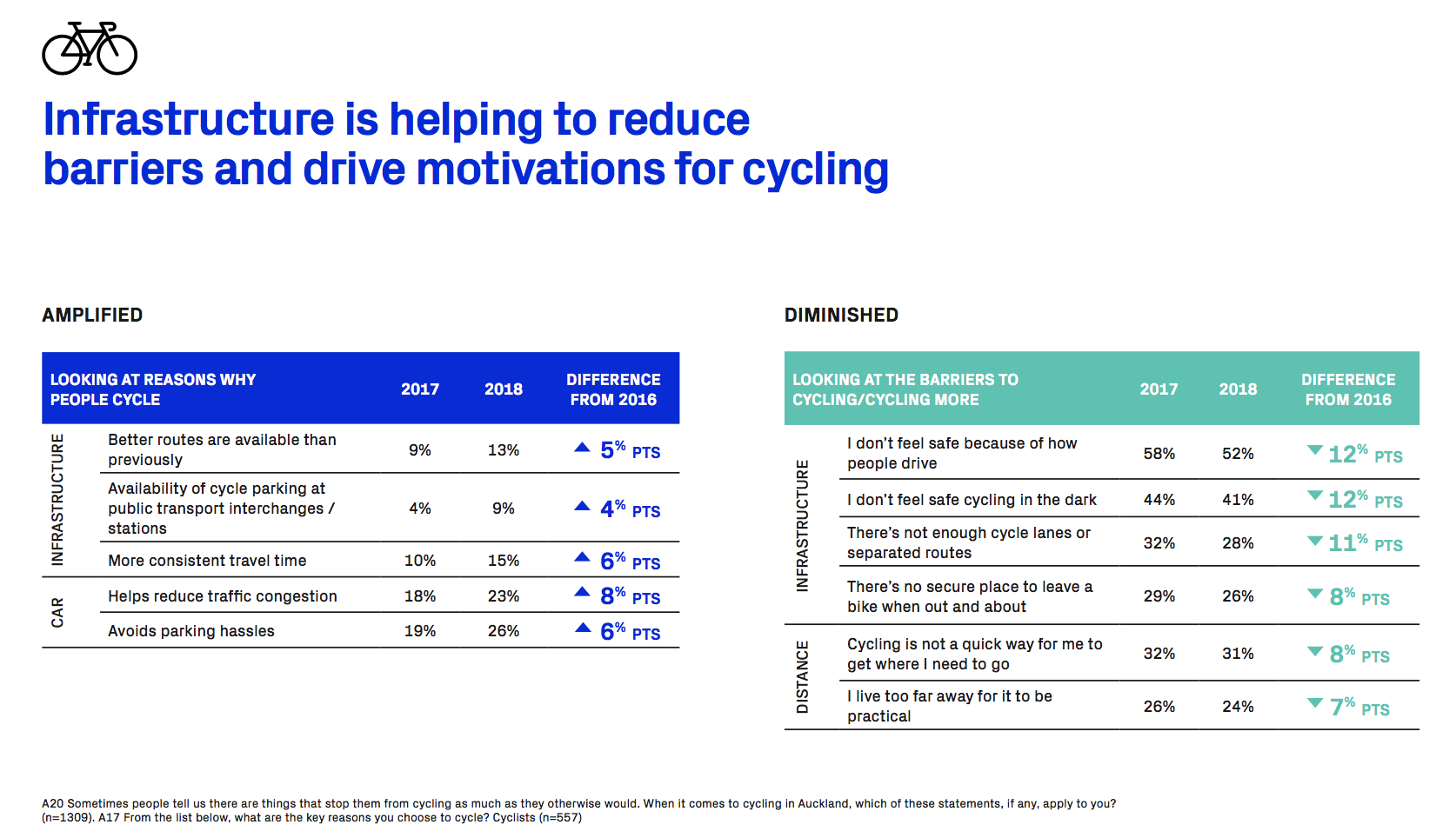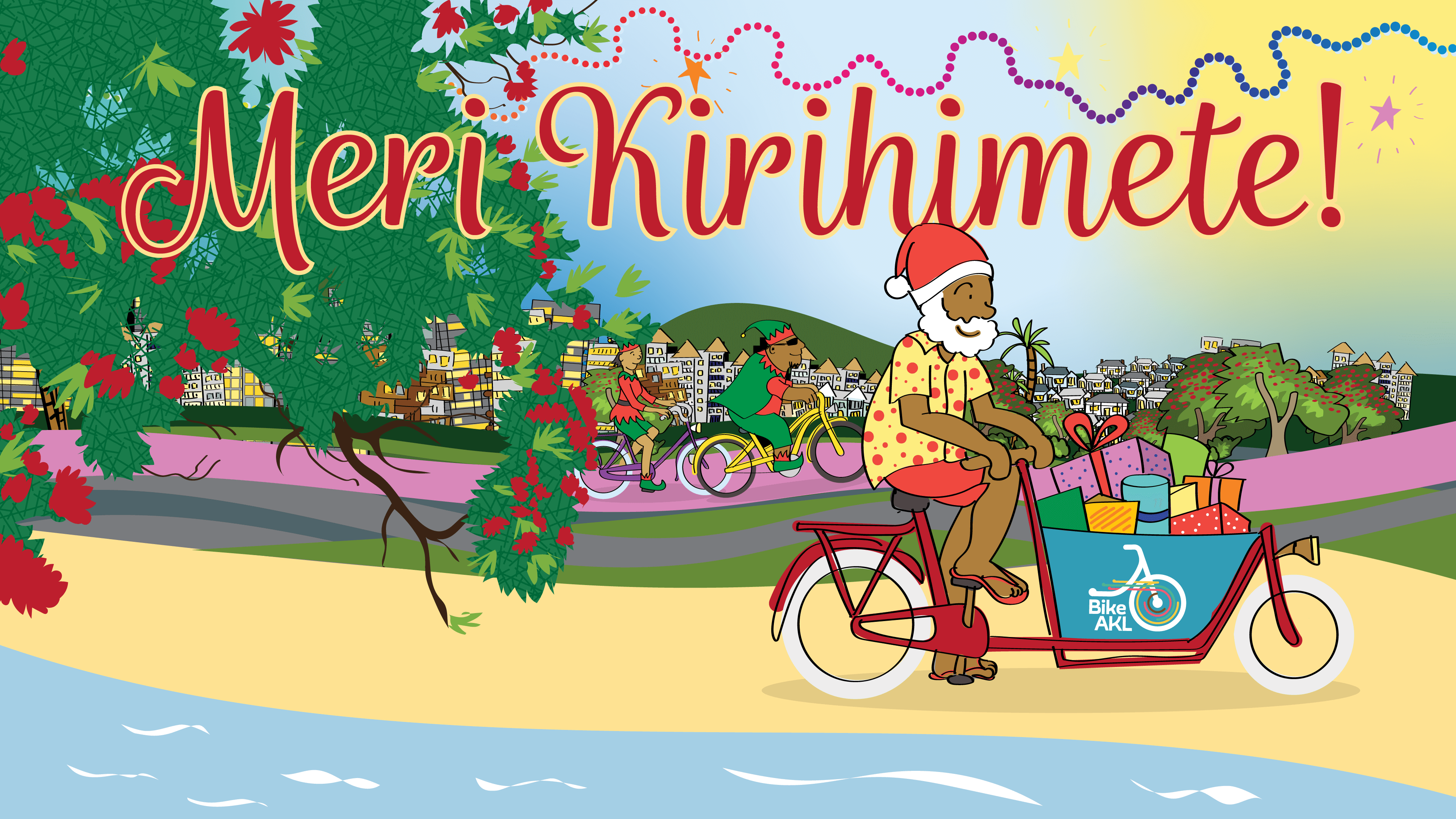Every year, to round out the bare-bones data the automatic cycle counters supply, Auckland Transport commissions independent research, interviewing a representative sample of Aucklanders by location, age, and gender to find out what people think about walking and cycling. (We’ve covered previous surveys here and here.)
Note: the screenshots below are from the full research report by TRA, which is located here.
Long story short: the 2018 report confirms what our eyes are telling us as we travel around the city – there are more of us on bikes than ever. And people are feeling happier about bikes in general, and bikes in their community in particular.
This is the result that’s leading the headlines – and for good reason, as it represents a major flip since the survey began five years ago: two thirds of Aucklanders agree that bike lanes and bike paths are a good thing for the community. And the majority of Aucklanders are positive about cycling in their own community (with a substantial neutral group in there, just waiting to be convinced). The sidebar has quite an interesting spin on where the opposition to cycleways is coming from, too.
Some of this positivity surely comes from a rise in the number of people who bike, even occasionally: one in four Aucklanders now say they hop on a bike at least once a month, giving a total of 518,600 people who bike at least monthly (and ~52,800 new cyclists in the last year alone).
So where are those new riders coming from? Unsurprisingly, they’re emerging from the big middle: the curious but concerned, the considerers and occasional riders. Slowly but surely, people are edging across the ‘adoption framework’, from nah to yeah. 
In particular, growth is happening amongst young people (go millennials!), Asian Aucklanders, child-free working folk (whether sinkies or dinkies), and families, too. Again, this accords with what our eyes are telling us, both out on the bike paths and in neighbourhoods.
The survey also tracks a rise in ‘social acceptance’, and suggests a correlation: the more positive messages you hear about cycling from people you like and trust, the more inclined you are to start riding or keep riding. That’s cool. And even people not on bikes – the last two questions on the graph below – are noticing more family, friends, and colleagues taking up cycling. 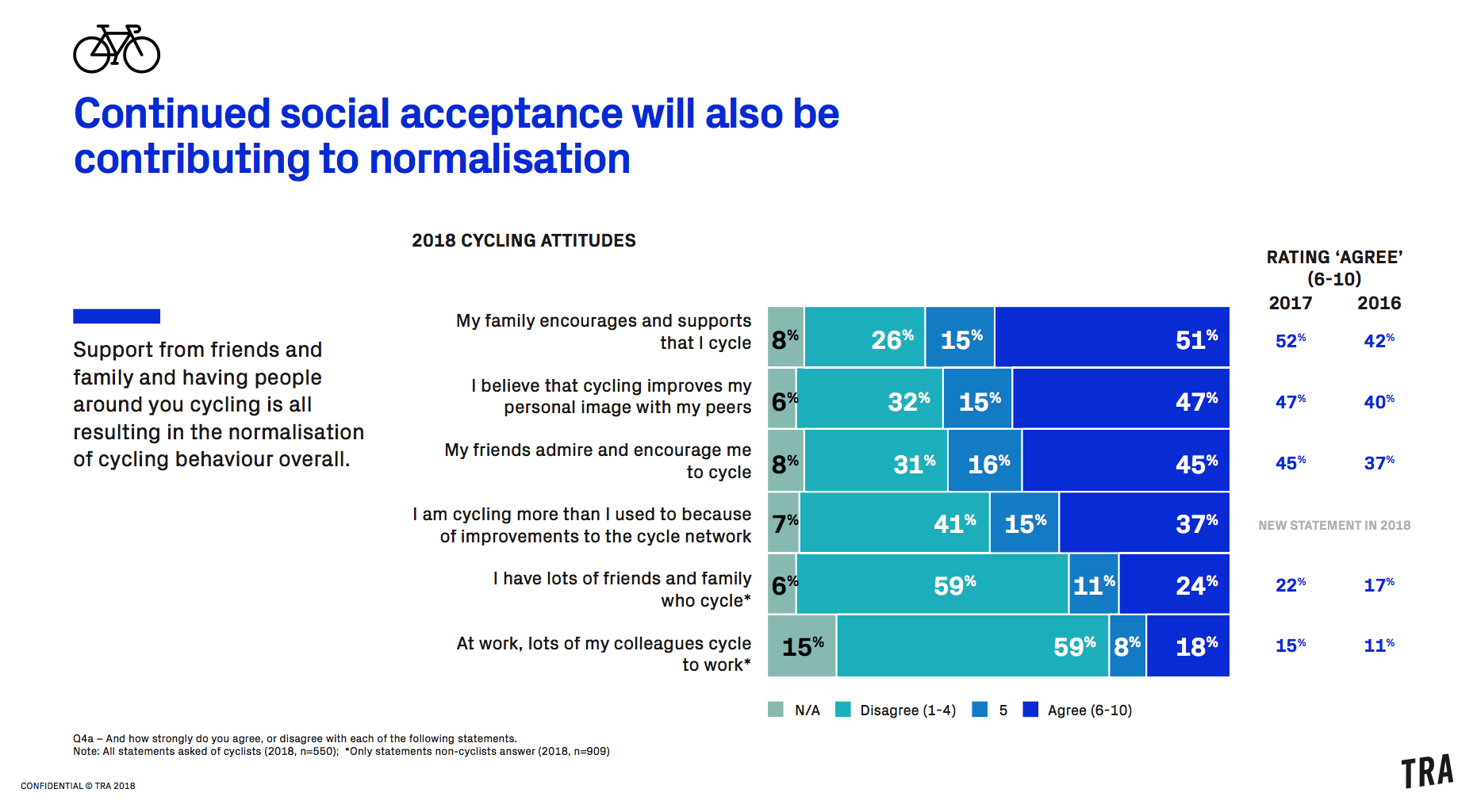
In a turn of events that will surprise literally nobody (especially those who follow the cycle-counter data): more people are cycling where cycleways have been built, improved, and joined up. ALL TOGETHER NOW: IF YOU BUILD IT YEP YOU KNOW THE REST.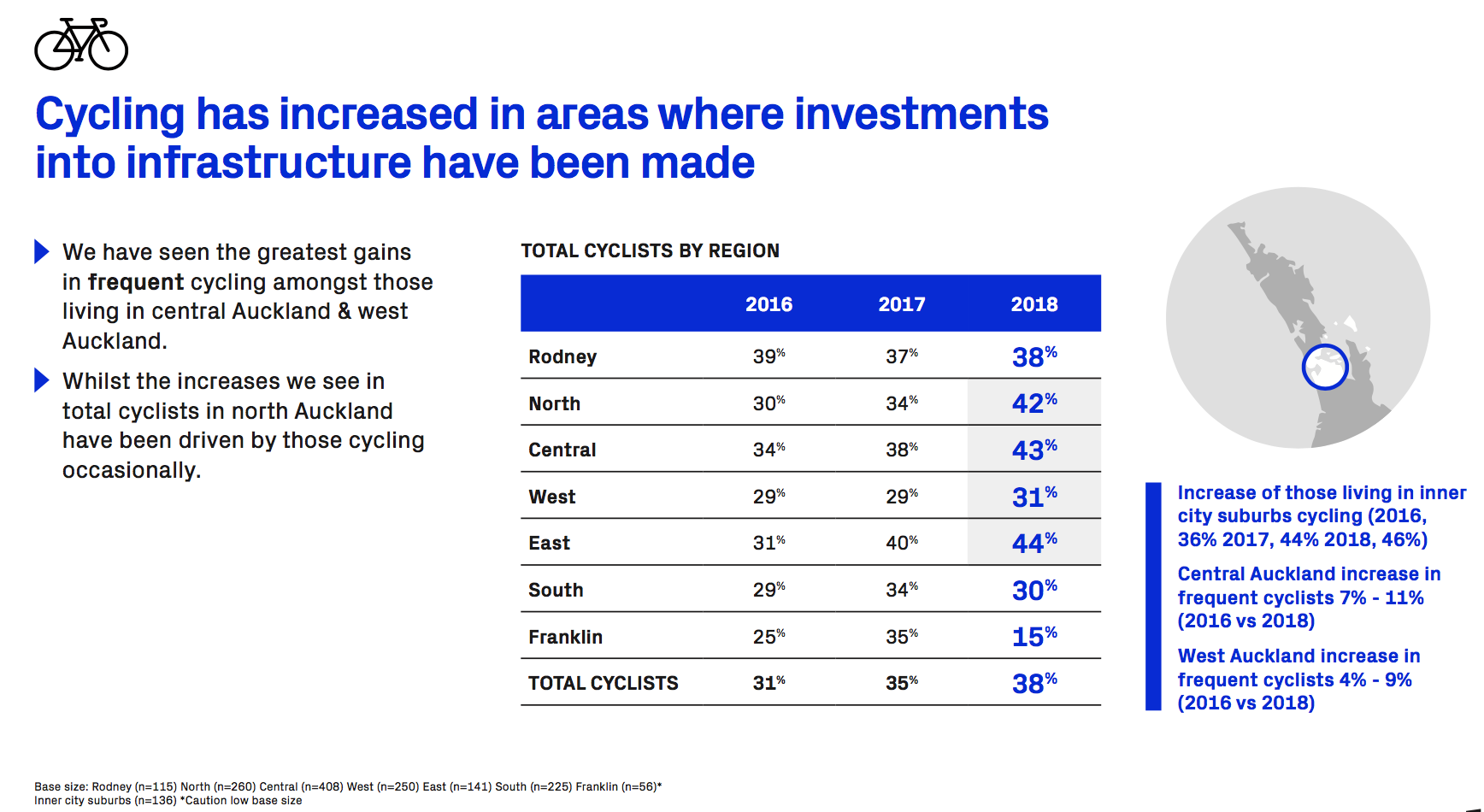
What kinds of trips are people making on bikes? Well, we’re still quaxing like crazy: lots and lots of shopping trips on bikes. And the smaller demographic of bike to school/study is sitting steady-ish.
But look at the rise in people biking to work and trip-chaining to public transport. BOOM: there it is, a growth in daily trips taking cars off the road and maximizing the reach of buses, trains, and ferries. 
Pause for thought: imagine the even bigger numbers you could unlock with strategic targeting of safe bike routes to and from transport hubs, and with a strong understanding of where people want to ride to work. (Like, for example, hospitals and other major health employers in the middle of the isthmus).
Now imagine if, as well as building out the congestion free network, you gave each hub a radius of ten minutes’ safe walking or cycling… you’d get something like this. A walkable, bikeable, public-transport empowered city. Seems like a strategic slam-dunk, no? And wouldn’t you build the quick and affordable part NOW, while starting on the longer-term large scale projects like LRT?
Okay, back to the survey: the other thing about all these people riding of all sorts of journeys is, they scatter cash along the way, like a rolling lolly scramble. Check it out.
The shopping and cafe-crawling is great, and should help retailers relax a bit about the prospect of bike lanes along shopping streets – cycleways are like those permeable hoses that lie in your vege garden, steadily sprinkling water and keeping your garden going through every drought – they’ll bring life to town centres, and town centres to life.
But our eye is also firmly on that 11% who pick up or drop off children along the way. Family logistics can be a major barrier to more women cycling (bearing in mind, fewer women than men ride in New Zealand as in many places, even though plenty want to – whereas in countries where there are fewer barriers to cycling, more women ride than men). Being able to fold the kids into your daily travels is absolutely key, not just to logistics, but to public health, independence, and reducing congestion, creating a ‘school holiday effect’ on the roads, year round. Solve the school run and you solve the city, basically.
Another factor that’s changing the way people feel about biking (whether tackling hills, covering long distances, or hauling cargo, like kids) is of course the e-bike revolution. Again, AT’s survey backs up what we’re seeing out there anecdotally. Aucklanders are taking to e-bikes like ducks to water. Increasingly, the racks at an average inner-city supermarket will feature a classic ten-speed, a mountain-bike… and two or three e-bikes with panniers.
Sidebar: What’s striking about the slide above is the survey’s estimate of 41,000 e-bikes in Auckland alone. Sales numbers for e-bikes are hard to come by, but import numbers suggest ~20,000 e-bikes came into the country in 2017, up on ~14,000 the year before. Effectively, e-bike sales have been growing exponentially for the last several years, and it wouldn’t be surprising if a large proportion of the total fleet is in Auckland.
Whatever the current e-bike fleet size and Auckland’s share of it, what does this e-bike enthusiasm mean for Auckland’s future? A recent NZTA report into e-bikes and other low-powered e-vehicles ran a range of forecast sales scenarios, based on other countries with similar conditions. (Note, the numbers below are ‘sales per year’ not ‘cumulative fleet on the roads.’)

Meanwhile, when it comes to what stops people cycling more often, and what encourages them to cycle more often, things seem to be generally moving in the right direction.
Significantly, the strongest barrier to cycling is driver behavior. This is a wake up call to AT to act on the staggering rise in deaths and serious injuries that has occurred on its watch. Also worth noting: around one in four people who ride say they’re doing it to avoid congestion and parking hassles. As word gets out that biking to work is a smoother ride all round, watch that number continue to climb.
Overall, the 2018 Active Modes survey is an encouraging read. It confirms we’re on the right track: Aucklanders of all ages and backgrounds want to be able to ride more often, and feel better when they do. It also captures a tipping point – not only are more of us riding and asking for safer conditions in which to do so, but in general we have our fellow citizens backing us. It’s time for change.
As always, of course no single survey can capture every angle, and conditions are changing all the time. For example, bikeshare probably arrived slightly too late on the scene to be taken into account. So here’s our question for you: what other questions would you ask, if you were surveying Aucklanders at large about cycling – and regular riders in particular? What kinds of data would help you answer questions, or make the case when talking to friends, employers, and the city at large? What’s missing from the conversation? We’re all ears!

